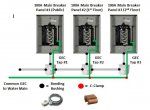Jerramundi
Senior Member
- Location
- Chicago
- Occupation
- Licensed Residential Electrician
I'm working on correcting an existing installation right now that will require me to run a common GEC for 200A AWG Overhead Service Conductors and tap off it 3 times to 3 individual 100A Main Breaker Panels.
Not a typical installation for me, so any ideas would help. Right now I'm thinking of running a common GEC from the water main to j-boxes below each panel and using a c-clamp in each j-box to tap off it for each respective panel.
Seems to me this would be the more cost effective solution as opposed to running 3 separate GECs for each 100A panel...
Thoughts? Ideas?
Not a typical installation for me, so any ideas would help. Right now I'm thinking of running a common GEC from the water main to j-boxes below each panel and using a c-clamp in each j-box to tap off it for each respective panel.
Seems to me this would be the more cost effective solution as opposed to running 3 separate GECs for each 100A panel...
Thoughts? Ideas?


